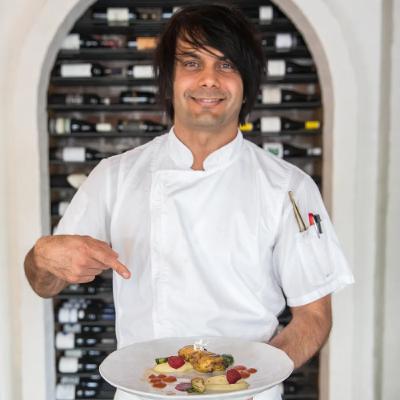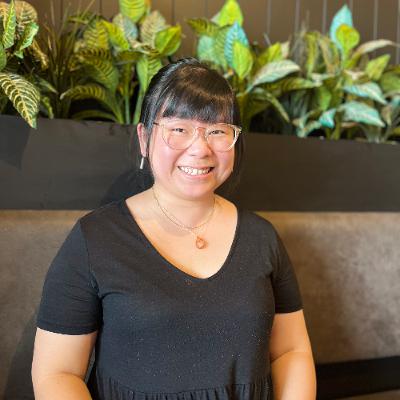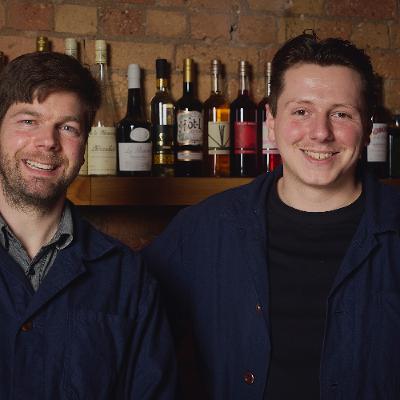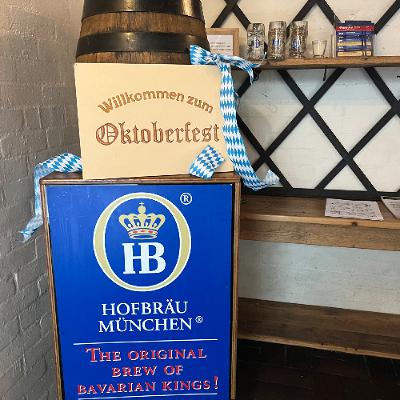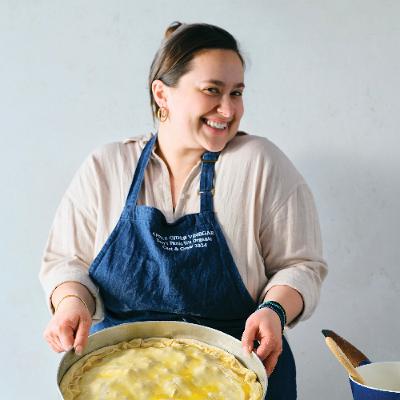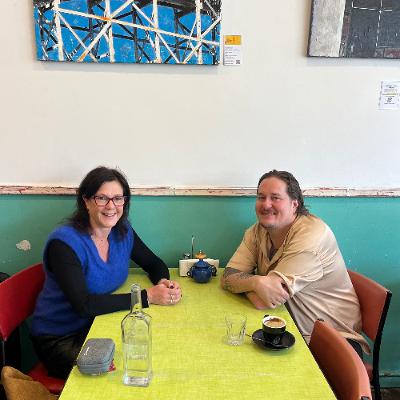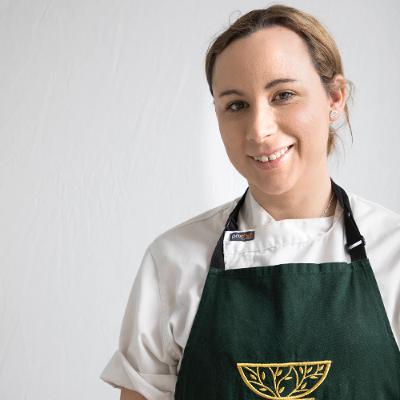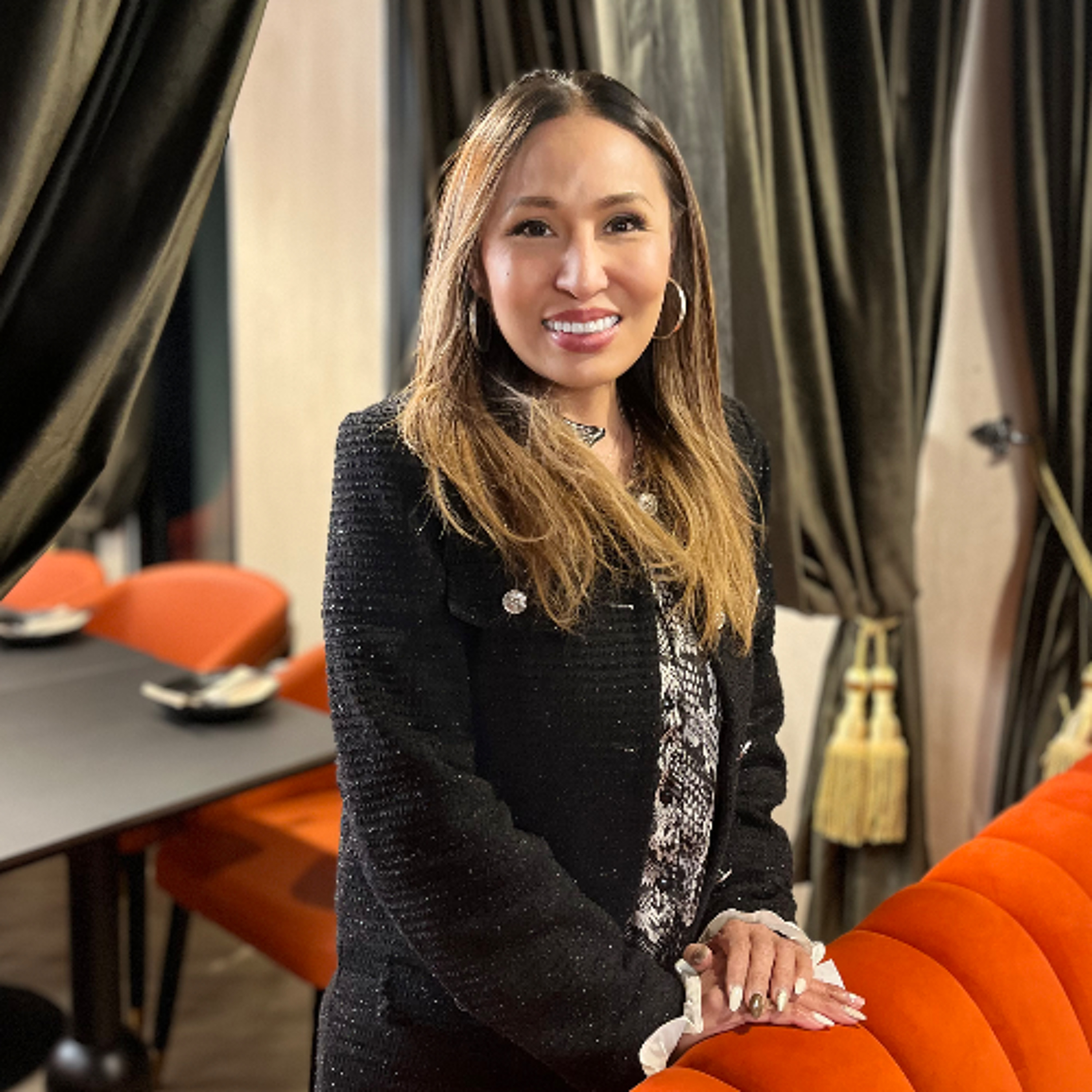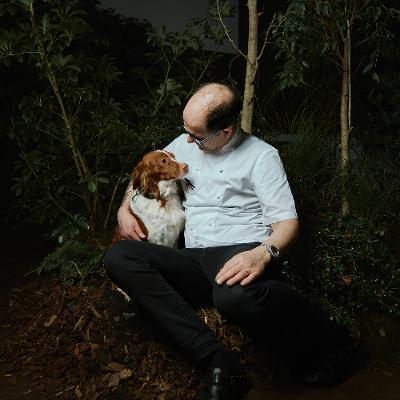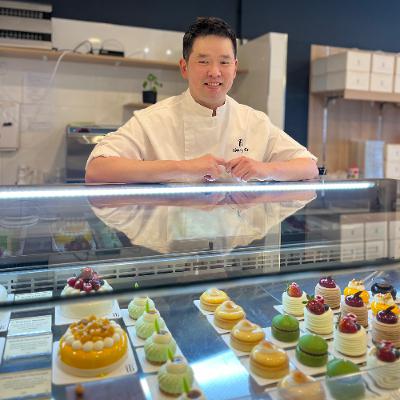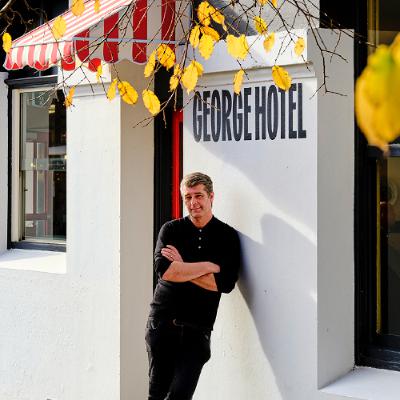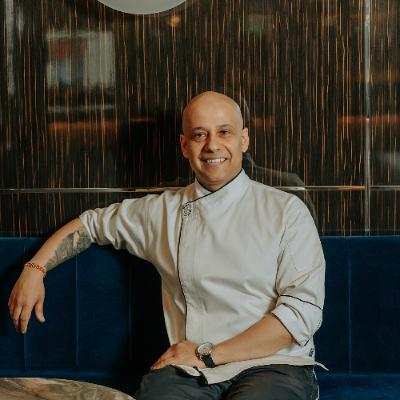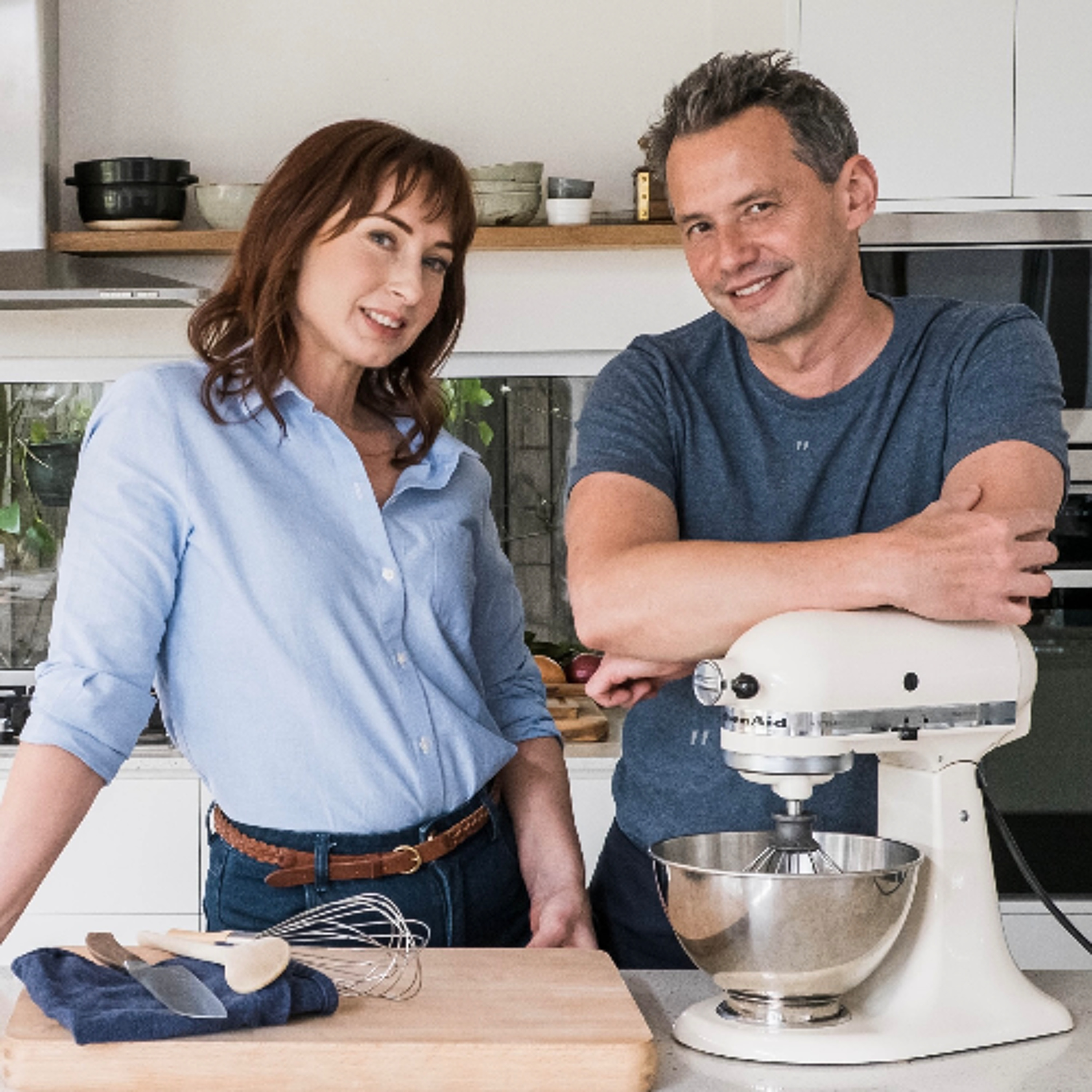Discover Conversation with a chef
Conversation with a chef

Conversation with a chef
Author: Jo Rittey
Subscribed: 47Played: 2,160Subscribe
Share
© All rights reserved
Description
Ever wondered what goes on in the kitchens of Melbourne’s restaurants? Conversation with a chef gives the back story of our city’s favourite eating spots. This is not a slick podcast, in fact it's pretty rustic. I'm Jo Rittey. I'm a French teacher and food writer and not that great on the technology. What you'll hear is the conversation how it happened, with no bells and whistles. I'll work on that!
320 Episodes
Reverse
Sincero in Malvern is the second restaurant from chef Mirco Speri and the team behind Buono in Parkdale. While Buono captures the easy warmth of a bayside trattoria, Sincero brings a quieter confidence to Glenferrie Road. Open since April 2024, it’s already known for what Mirco calls Italian my way: familiar flavours, local produce, and the occasional twist; like seaweed inguine with Moreton Bay bugs and blood orange jelly. Mirco has spent three decades cooking around the world, from Michelin-starred kitchens in Europe to Melbourne’s evolving dining scene. At Sincero, that experience shows in food that feels both grounded and instinctive. He’s not chasing trends or nostalgia; he’s cooking with sincerity, curiosity, and the kind of calm assurance that only comes from doing something you truly love.
buymeacoffee.com/conversationwithachef
Today I’m chatting with Anuj Sanghi, who’s opened Bar Mercado on Peel Street, right across from the Queen Victoria Market. The name Mercado means “market” in Spanish, and that’s really the heart of what Anuj has created, a place for people to gather, share food, drink, stories, and cultures. Every morning he walks over to the market to hand-pick his produce, chatting with the traders and letting what he finds inspire the day’s menu. The food at Bar Mercado is a vibrant mix of South American, Spanish and Latin flavours; think wood-fired chorizo with chimichurri, oysters with chilli and lime granita, slow-cooked lamb sandwiches and churros with dark chocolate. It’s not fine dining, but you can feel the finesse of someone who’s worked at places like Maha, Rockpool and Entrecôte. Anuj moved from Delhi to Melbourne to study at Le Cordon Bleu and never looked back. We talked about how his mum inspired his love of food, what he’s learned from his mentors, and how he’s building something that feels like community.
Atta in Albert Park has quietly and confidently become one of Melbourne’s most enduring modern Indian restaurants. It’s been ten years since it opened, which is no small feat in this city, and behind it all is chef and owner Harry Dhanjal. Harry has spent that decade redefining how we think about Indian cuisine, balancing innovation and tradition, respecting the roots of each dish while bringing them to life in a contemporary, elegant way. Atta isn’t fusion, as Harry says, it’s modern Indian: thoughtful, beautiful, and deeply grounded in flavour and culture. We talked about the early days of Atta and what it took to get people to see Indian food differently, the fine line between innovation and tradition, and why for Harry, being a chef is as much about discipline and joy as it is about technique.
When I walked into Aegli in South Melbourne, the first thing I noticed was the light: soft, golden, everywhere. Then I met Ioannis Kasidokostas, and it makes even more sense. Aegli was a goddess, Yanni tells me: elegant, dazzling, radiant, and that’s exactly what he’s built here. The space, the food, the feeling. Yanni doesn’t see hospitality as a job. He calls it a culture. It’s about philoxenia, the Greek art of making a stranger feel like they’ve come home. It’s there in how he talks about his team, the way he refuses to rush a service, and the stories woven through every dish. We talked about patience, trust, and what it means to build something that glows from the inside out. We talked about a raw prawn and nectarine dish that started as a lesson from his fisherman grandfather, a 90-day kopanisti that’s worth the wait, and a philosophy that Greek cuisine doesn’t need to reinvent itself, it just needs to remember where it came from. Aegli means light, but it’s also warmth. And I think that’s exactly what Yanni is serving. This was a wonderful conversation and I feel all the better for having met Yanni and chatted with him.
Today I’m chatting with Rachel Miyazaki from Niji Sweets. If you’ve walked through Queen Vic Market lately, you might have stopped in your tracks at a stall that looks more like a jewellery counter than a lolly stand: trays of shimmering kohakutou, those jewel-like Japanese sweets that catch the light and your imagination all at once. Rachel trained as a pastry chef, working everywhere from LuxBite to Marvel Stadium, but with Niji Sweets she and her friend Yiying are doing something entirely different. We talked about how a childhood love of baking, a detour through computer studies, and a trip to Japan all converged on these edible crystals. From the patient, days-long process of crystallising agar to the thrill of seeing someone’s face light up when they bite through that crunchy shell into soft jelly, Rachel is bringing something rare and beautiful to Melbourne and I am very happy to have had the opportunity to sit down with her and hear all about it.
When Luke’s Bánh Mì opened in the CBD, the response was extraordinary. Queues ran down Little Bourke Street, and more than 1,200 bánh mì were sold that first day. In fact, customers were averaging two or three each, so the real number was far higher. I went to the preview and then couldn’t resist coming back the very next day just to see it all unfold. I even filmed the line, and for the first time ever, something I posted went viral. But the real story is bigger than one opening. Luke Vu is a third-generation Vietnamese baker whose journey began in his family’s bakery in Ho Chi Minh City, with memories of wood-fired bread and early morning deliveries on his bike. After moving to Melbourne and completing a university degree, Luke still couldn’t shake the pull of the bakery. The lure of bread, pâté and pickles was too strong, and he soon set up his own shop, first in Reservoir, then in Moonee Ponds and South Melbourne, where the bánh mì quickly became local fixtures. That history, and the hard work behind every detail, made the leap into the city all the more powerful.
Collingwood has no shortage of bars, but Babines stands out, thanks to the two Juliens behind it, Julien Pascal and Julien Wurtlin. When I first ducked in not long after they opened a year and a half ago (on the recommendation of a French friend, naturally), I was hooked: the cocktails, the anchovy toasts, the way the place already felt like it belonged. Since then, the pair have kept shaping and reshaping the space themselves into something great; renovations, late nights, a little trial and error. What started as a cocktail bar has grown into a neighbourhood dining room, where you can order salt cod fritters with that sharp little Caribbean sauce, or a Victorian hanger steak that rivals anything in France. The drinks list shifts with the seasons, equal parts French roots and Melbourne edge, and the late-night kitchen has made Babines a magnet for the industry crowd. I sat down with both Juliens to hear how they pulled it off: the DIY headaches, the Collingwood quirks, and why taking their time was the best decision they made.
I’ve spoken to Sunny Gilbert at Melbourne’s Hofbrauhaus before and it was such a delight to catch up with him again, especially at this time of year. He’d just flown back from Munich, where Oktoberfest really is as big, loud and joyful as everyone says: ten beer tents, each crammed with 10,000 people, steins thudding on tables, bands lifting whole crowds onto benches. Back in Melbourne, at Hofbrauhaus, Sunny and his team are keeping that spirit alive all October: bigger bands, stronger beer, stein-holding contests, and plenty of schnitzel and knuckle to go around. Get your Dirndls and Lederhosen on and let’s go! Now, I have a spring head cold, so I apologise for my voice. I’d like to think it sounds resonant and alluring, but I am fairly certain it just sounds like I have a cold. The show must go on.
Lorcán Kan has one of those reputations that precedes him, not in the loud, headline-grabbing way, but in the quiet way that matters more. Mention his name to other chefs and their response is usually the same: “He’s such a lovely guy.” Kan, now head chef at Etta in Brunswick East, carries that reputation with the same understated composure he brings to food. Born in Donegal to an Irish-Malaysian family and in Melbourne since he was one, Kan grew up resisting his dad’s Malaysian cooking (hot dogs seemed more appealing at the time) before circling back to it as comfort food. His path has been anything but linear: New York fine dining, German art studios, years of travel guided by one-way tickets and kitchen doors that opened when he knocked. He’s studied food science to answer the “why” questions, explored fermentation before it was fashionable, and learned that creative control is as much about restraint as it is about freedom. At Etta, his cooking sits at that intersection; comforting but restless, grounded but curious, waste-aware but playful. Talking with Kan feels like talking to someone who still finds wonder in the work. He’s calm, thoughtful, and very much the real deal.
I’m upstairs at Eleni’s Kitchen in Yarraville with Eleftheria Amanatidis. The room feels like a taverna: a criss cross of dark beams, low light, and the sense that food is at the centre of everything. Eleftheria has captured not just the dishes of her Yiayias and Papous, but the atmosphere too: the smells, the rituals, the family gathered around a table. Hospitality runs in Eleftheria’s blood: her family opened Yarraville’s first Greek restaurant opposite the Sun Theatre in the ’70s, back when Greek films screened on weekends and the jukebox played until late. That history of feeding Melbourne’s Greek community is part of what she carries forward now.Her recently launched book Ela na Fáme (Come and Eat) is both a collection of recipes and a love letter to that heritage; filo rolled thin with patience, pork and cabbage stew simmering on a winter’s day, and the call that anchored her childhood: “Come and eat.” While we were talking, her Yiayia Eleni wandered upstairs to look at old photos, a reminder that in Greek kitchens, the past is always at the table.
When I first spoke to Kyle Nicol back in late 2020, he was head chef at Rascal, and Melbourne was lurching in and out of lockdown. He was already thinking deeply about sustainability in kitchens, not just in terms of produce, but of chefs themselves. Five years on, Kyle’s covered a lot of ground: Lilac, Hazel, a string of pop-ups, consulting, foraging, and even a side project in charcuterie. He’s also hit burnout, had knee surgery, and taken a step back to reset. What hasn’t changed is his generosity, both in cooking and in spirit. Kyle’s the kind of chef other chefs call when they need help, the one who’ll share knowledge, jump on a service, or roll pasta at home just because. We caught up to talk about balance, identity in hospitality, and what it means to give your all without giving yourself away.
Brooke is a pastry chef with a flair for precision and a competitive streak that’s taken her from Sydney kitchens to the World Food Championships in Indianapolis, where her buttermilk cheesecake earned her third place in the world for dessert. She’s now preparing to return in October to take out the top spot all while juggling recipe testing, private chef gigs, and her educational platform Capture the Chef as well as packing her own sugar for the competition because, as she puts it, “Australian sugar tastes better.” Talking to her when she was in Melbourne, I got the sense of someone who thrives on high stakes but carries it lightly: meticulous yet unflappable, and deeply in love with sharing food and technique with anyone curious enough to watch.
The name Odette House came to Jojo Parkinson at 4.30 in the morning. Later, she discovered it meant “prosperous,” which felt right for a venue with three distinct levels: an all-day café downstairs, Uday restaurant upstairs, and a rooftop bar with a view of the city. Uday means “sunrise” in Sanskrit, a nod to new beginnings. Over her ceremonial-grade Matcha on a Cloud, Jojo spoke about building a neighbourhood space, steering clear of the word “fusion,” and keeping a loyal team by her side for nearly a decade.
Joe Vargetto has turned his restaurant into a truffle wonderland. Step inside Mr Bianco’s little bar, Bianchetto right now and you’ll find moss, fairy lights, oak leaves, and, if you’re lucky, a truffle-hunting spaniel on duty. Some chefs talk about truffles as a luxury. Joe talks about them as if they’re alive, creatures that seduce trees, steal nutrients and transform the soil they grow in, but he’ll also describe them as magical. He’ll tell you they work just as well on a toasted cheese sandwich as they do on a tasting menu. There are plenty of restaurants in Melbourne celebrating truffle season, but only Joe thought to bring the farm indoors. I always love catching up with Joe. He’s so generous with what he shares, and he really wants to share everything. We roamed the restaurant, taking in the enchanted forest in Bianchetto, which means white truffle in Italian, the Staub range of ‘white truffle’ crockery Joe is working with for this venture and upstairs to see the photo from 2001 when he took part in the Bocuse d’Or, encouraged by his friend and mentor, Philippe Mouchel, and of which one of the sponsors was Staub. Long story short, it is all very serendipitous and absolutely charming.
In Carnegie, there’s a little patisserie turning out some of the most beautiful cakes in Melbourne. Tommy Er’s T6 Patisserie has been open just over a year and already has a loyal following, very definitely including me. Tommy’s pastries are French in style but layered with the flavours he grew up with in Southeast Asia. There’s pandan sponge with custard inspired by his great-grandmother’s onde-onde, mango lime cheesecake, glossy, precise cakes that look almost too perfect to eat - definitely eat them - and a Hazelnut Rocher cake that tastes exactly like the chocolate it’s named after; a crowd favourite and Tommy’s personal pick. Tommy has been in kitchens since he was 13, learning both Malaysian and French techniques, and still tests and tweaks every creation until it’s exactly how he wants it. It turns out that Tommy’s secret ingredient isn’t pandan or chocolate or caramel, but patience.
The drive into The Dining Room At Lancemore Lindenderry in Red Hill takes you past rows of vines and manicured gardens that open out to 38 acres of rolling lawns, a tennis court, wood-fired hot tubs and 41 elegant rooms. It’s the sort of place you can settle into for the weekend or drive down for lunch and wish you’d booked a room. In the kitchen is executive chef Nick McGonigal. He started cooking at Red Scooter Events before moving into Melbourne institution Cecconi’s, before crossing the world to spend two years as chef de partie at Brett Graham's three-Michelin-starred restaurant The Ledbury. Back in Australia, he cooked at Bentley Restaurant and Bar in Sydney, before moving home to Melbourne and working at Society then Paringa Estate. Ten years after his apprenticeship, he’s leading the kitchen at Lindenderry. We talked about the move from winter to spring, a citrus and lavender dessert served with a burst of liquid nitrogen, the balance between creativity and spreadsheets, and why the story behind an ingredient matters to him.
I had dinner at The George Hotel in South Melbourne the night before this conversation, and I’m still thinking about that prawn toast. The parma came on the bone, the romesco on the pumpkin was deeply smoky, and the vibe was spot on. Fire crackling, carpet slightly retro, and classic pub food done with care, generosity, and just the right amount of zhuzh. Usually on this podcast I speak to chefs, but hospitality goes far beyond the kitchen. My guest today is someone who’s been quietly transforming the pub scene across Victoria. Scott Connolly is a publican, but not the kind who simply owns the building and turns up for the soft launch. He’s a former actor and musician who’s worked every inch of the floor and now oversees venues like the Healesville Hotel, the Orrong, and most recently, The George. We talked about pub culture, people, parmas, carpets, and what it means to be a custodian of these places that mean so much to so many.
Two years after our first conversation, Pawan Dutta has made the kitchen at The Royce Hotel entirely his own. The Showroom Bar still gleams. The menu is bolder, with flavours that travel from Peru to France and back again, yet nothing feels forced. He’s as hands-on as ever, still on the pans, still chasing that perfect balance of craft and instinct. We talk about how the team has evolved, the trust that keeps the kitchen running smoothly, and why hotel restaurants like this deserve to be taken seriously.
Stéphane Nguyen is the founder of the French Cooking Academy alongside his wife, Kate. Stephane has built a global following by teaching classic French techniques in a way that actually makes sense: clear, methodical, and with a real focus on understanding the why behind each step. But it didn’t start there. Stéphane moved to Australia, missed French food, tried to make a Boeuf Bourguignon and realised he actually had no idea how. So he taught himself, using proper French culinary textbooks, and documented the whole process. What started as a personal project is now a full-blown online cooking school with thousands of students from around the world. We talked about everything from confidence in the kitchen to why a sieve might be the most underrated tool you own. We talked about how the Academy came to be, what it means to build confidence in the kitchen, and why the simplest dishes are often the hardest to get right.
If Pepe’s Italian & Liquor is all swagger and spectacle: snow machines, themed decor, and a big personality, then Pepe’s Parlour offers something quieter and more composed. The original venue opened in 2019 in a former synagogue on Exhibition Street, serving Italian American classics in a space that leans into old-school New York glamour. Next door, Pepe’s Parlour channels the elegance of a London members’ club, softened by a Melbourne sensibility: martinis, soft light, hand-painted tomato murals. It’s also where Antonio Loffredo is doing quietly brilliant things in the kitchen. Antonio grew up in Campania and then the Amalfi Coast and started making pizza in his father’s shop at 16. He has worked across just about every section of a kitchen since arriving in Melbourne more than a decade ago. Now head chef at the Parlour, he’s turning out focaccia made from a slow-fermented dough, fresh pasta, and light, lunch-friendly plates that still manage to feel generous. We talked about the emotional pull of food, why he won’t use bread with a 15-ingredient label, and how a baking course during lockdown completely reshaped the way he cooks.




